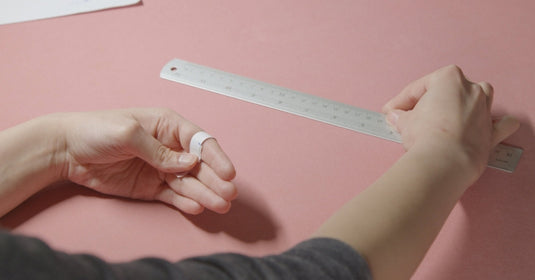You're about to buy a ring. Or maybe someone is buying you one. But here’s the part nobody likes to deal with: ring sizing. You’d think it would be easy. Find the size and move on. But it turns into a weird guessing game. Too tight and it’s a struggle. Too loose and you’re scared it’ll fall into a drain.
Let’s skip the drama. This is your no-frills, human-friendly guide to figuring out ring sizing at home without expensive tools or shady online quizzes.
Why Ring Sizing Gets Overlooked (But Shouldn't)
Here’s the thing. People assume ring size is just a small detail until it’s wrong. Many jewelers will resize rings if necessary, but some designs won’t survive it. Stones shift or bands get distorted. And sometimes the ring just doesn’t feel right after it’s been altered.
Getting the size right the first time? It matters more than you think.
What tools can you use at home?
It's not necessary to buy a special kit in order to determine your size. You probably have everything you need in your drawer, including string, paper, and a ruler.
The right tools can make all the difference, whether you are printing out a chart of ring sizes, wrapping floss around your fingers, or trying on adjusters. Don't just rely on your memory or guesswork. The rings are small, but errors can be costly.

What If You're In Between Sizes
It happens more often than you might think. You may be in the middle of two standard sizes and not know whether to go up or down. It's best to order a size larger than you need and then adjust as needed. Ring sizing beads and adjusters are a great solution. You can fine-tune your fit without making a permanent adjustment.
Option 1: The String Method
You've seen it before. Take a thin strip of paper, paper floss, or string. Wrap the band around your finger's base (not too tightly). Mark the overlaps. Measure in millimeters by laying it flat.
Use a ring sizing chart to convert mm into ring sizes.
Human tip: Fingers swell. Measure at the end of the day when your hands are still warm. Morning fingers lie.
Do it again 2–3 times. It's not your imagination. You can have a slight change in size depending on the temperature, salt, and even stress. You are a human.
Option 2: Use an Existing Ring
You're in luck if you have a ring that fits the finger you are buying for. This is the easiest way. Get a ring sizing chart that shows the actual size of circles.
Place your ring on the circles and keep doing so until you find one that matches. The inside edge should line up with the circle outline and not the outside.
Do not just look at it on the screen. Print out the chart in 100% scale. If you don't, then you are back at square one.
Want help double-checking your chart? Visit Chawi Jewelers for expert guidance.
Option 3: Buy Ring Sizing Beads (or Sizing Adjusters)
You may already own the ring. It's just a little loose. You may be gifting a ring, and you are not sure of the perfect size. But you don’t want to risk it.
Ring sizing beads are the perfect solution. These are tiny metal or clear beads that a jeweler can place inside the band to tighten it. They are usually reversible.
Online, you can purchase temporary adjusters that slide onto the backside of the ring. These aren't glamorous, but they do the job.
This hack is great for a size in between, weight changes, or giving without guessing.
Some Common Sizing Errors
Here are a few things that people won't tell.
- The dominant hand is larger. Size rings according to the finger that you will wear them on.
- Wider bands are tighter. You may need to go up a half size if the ring has a thick or chunky feel.
- If you have been under AC vents, don't measure the size of your fingers.
- Your fingers are affected by sodium. Wild.
Why You Should Visit a Jeweler
You can size rings at home. It's sometimes worth having it checked by a professional, particularly if you are buying a ring of high value, like an engagement ring. Or if you are working with unique or vintage pieces. Or maybe you’ve had size issues before, such as fluctuating weight.
Jewelers use metal ring sizing tools, which are more accurate than paper and string. They can also help you with edge cases, such as knuckle or base sizing, or how tight the band should feel.
Final Thoughts: Size Is Only Noticeable When It Is Wrong
Here's the reality. Nobody compliments the rings for the right size. If it's too small or it keeps spinning, you will think about it all the time.
This is why ring sizing is important. It's more than a mere technicality. This is part of what makes the ring feel like yours.
Take a moment to consider your purchase, whether it's for you or someone else. If you are not sure, use a ring sizing chart or the string trick. You can also check your existing rings. This is better than resizing and guessing. You can do it.
Prefer a professional fit? Schedule a consultation or fitting at Chawi Jewelers.
